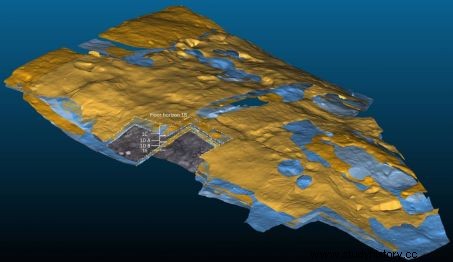Exploring the basements of Ribe, Jutland, on the Danish coast, sheds light on how the first Viking Age town emerged in the early 8th th century, in a world that did not know these urban spaces.

In the VIII th century in Ribe (Denmark), at the dawn of the Viking Age, bead makers used pieces of glass from old Roman mosaics as their raw material.
But where did they get all that? These colored glass beads, amulets and other silver coins... These treasures emerging from the depths are among a multitude of remains recently exhumed by Danish archaeologists in the muddy basements of the old Ribe, at the western Denmark. The oldest Viking city, with Birka (750) in Norway. No agglomeration of this kind existed until then in the Scandinavian world.
Now located in the municipality of Esbjerg, in the Syddanmark region of Jutland, Ribe was founded around 700. It was mainly a market by the water, with its alleys, and its quays wooden, which later became a starting point for Viking raids at sea. Throughout the Middle Ages and even into early modern times, Ribe was still one of the major ports of the North Sea and the Baltic .
However, despite its 1300 years of history, the emergence of the Viking past (VIII th -X e century) of Ribe is very poorly known. “His first period of occupation remains an enigma:how did Ribe settle in this part of the world where no one had ever lived in a city before? », if ask Danish scientists.
 Located 3m deep, the oldest levels of Viking occupations in Ribe. ©Northern Emporium
Located 3m deep, the oldest levels of Viking occupations in Ribe. ©Northern Emporium
In an attempt to answer these questions, archaeologists from the University of Aarhus associated with teams from museums in south-west Jutland, working with the support of the Carlsberg Foundation, have been painstakingly excavating this city since June 2017, as part of of a project called "Northern Emporium directed by Soren Michal Sindboek of Aarhus University. "While we know Ribe from large-scale studies as early as the 1970s, exploring its deepest layers is an event for us “, specified the specialists to the online magazine Videnskab . This work is in fact intended to clarify the evolution and dynamics of this pioneering urban network, based on the use of technologies such as 3D laser, DNA research and chemical soil analyses.
 3D Sanners used to document and analyze the areas of occupations of the Viking habitat of Ribe (Jutland). ©Sarah Cross / Northern Emporium
3D Sanners used to document and analyze the areas of occupations of the Viking habitat of Ribe (Jutland). ©Sarah Cross / Northern Emporium
Because port cities such as Ribe, with their trade networks, have played a crucial role not only in the development of navigation (with large ships that have become capable of transporting bulky loads, or of navigating the high seas), but also in Viking trade - first in Scandinavia between Denmark and Norway - before it reached more distant worlds. From the VIII th century, and for more than two centuries, this society without a central power scoured the oceans, from the Baltic to England, via Greenland, the coasts of America or the Arab world, multiplying exchanges like no no other group had done so before. And in Ribe, we witness live the beginnings of these transformations which herald the dawn of the Viking period. “The oldest floors - located 3 m from the current surface - are intact, which allows us to discover the history of Ribe decade after decade. Through this stratigraphy, we can see how the networks of the city have developed the scientists said. Thus they can witness the installation of the very first craftsmen through the found remains of ironwork, tanneries; among comb manufacturers, goldsmiths working amber, gold and silver, as well as copper, tin or lead alloys:"For example, originally, combs were fashioned from local deer antlers, then at the dawn of the Viking era, we see new raw materials appearing imported from Norway, the combs are then made of reindeer antlers... ".
 One of the many combs found in Ribe's Viking levels. ©Northern Emporium
One of the many combs found in Ribe's Viking levels. ©Northern Emporium
One of the most interesting aspects concerns the glass beads:in the ancient strata there were many small workshops where colored beads were worked, from ancient mosaic fragments probably recovered from tombs in the Roman cities of Cologne or of Trier (now Germany). This activity seems to continue for several generations. Then at the time of the advent of the Viking era, around 800, this local production was abruptly interrupted. We then see the mass arrival of pearls directly mass-produced in the Middle East!
 Glass beads are among the most common finds at Ribe and serve as markers for trade. From the IX
th
century, the majority of pearls came from the Middle East. ©Northern Emporium
Glass beads are among the most common finds at Ribe and serve as markers for trade. From the IX
th
century, the majority of pearls came from the Middle East. ©Northern Emporium
"These results thus demonstrate that this first city in the north appeared well before the development of a real trade with the Mediterranean and the Middle East “, add the experts. After gaining importance until the XVI th century, Ribe was the victim of a succession of tragedies:a fire in 1580, followed by serious floods in the 17 th century, followed by plague epidemics, before its port was silted up. So many disasters that have considerably slowed down its development.
